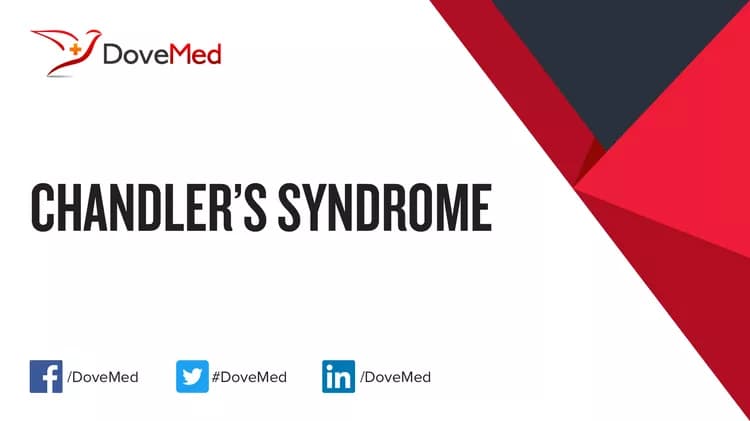What are the other Names for this Condition? (Also known as/Synonyms)
- CS (Chandler’s Syndrome)
- Iridocorneal Endothelial Syndrome (Chandler’s Syndrome)
- Iris Atrophy with Corneal Edema and Glaucoma
What is Chandler’s Syndrome? (Definition/Background Information)
- Chandler’s Syndrome (CS) is a rare disorder of the eye involving corneal edema (fluid buildup in the cornea), iris distortion, and glaucoma (an illness of eye pressure that can cause eye blindness)
- Chandler’s Syndrome can affect both males and females during middle-age, though research has shown that women tend to be affected more than men. Currently, no known risk factors are known for the condition
- The cause of Chandler’s Syndrome is currently not fully understood, but a defective endothelium (a tissue type in the eye) plays a part in the development of the condition. Individuals with Chandler’s Syndrome may experience signs and symptoms such as blurred vision, corneal swelling, and iris distortion
- A healthcare professional can diagnose Chandler’s Syndrome through an eye examination, analysis of past medical history, and specular microscopy. Upon diagnosis, the healthcare professional can design a treatment regimen to address the symptoms. However, there is no cure for Chandler’s Syndrome currently available
- Suitable and timely treatment can help improve the prognosis for individuals with Chandler’s Syndrome. Complications that may arise from the condition include glaucoma and vision loss. The prognosis can be poor, if early treatment to control the signs and symptoms is not undertaken
Who gets Chandler’s Syndrome? (Age and Sex Distribution)
- Chandler’s Syndrome tends to appear during middle-aged years, but can also occur in children and teenagers
- Females are more likely to be affected than males
- Individuals of different racial and ethnic backgrounds can be affected by CS
What are the Risk Factors for Chandler’s Syndrome? (Predisposing Factors)
- Currently, no known risk factors are available for Chandler’s Syndrome
It is important to note that having a risk factor does not mean that one will get the condition. A risk factor increases one's chances of getting a condition compared to an individual without the risk factors. Some risk factors are more important than others.
Also, not having a risk factor does not mean that an individual will not get the condition. It is always important to discuss the effect of risk factors with your healthcare provider.
What are the Causes of Chandler’s Syndrome? (Etiology)
The exact cause of Chandler’s Syndrome is currently unknown.
- Symptoms of Chandler’s Syndrome occurs when endothelium (a type of tissue) in the eye that pumps fluid from the cornea fails or dysfunctions. This leads to an accumulation of fluid within the cornea, resulting in the associated signs and symptoms
- The abnormal endothelium can also cause iris changes leading to further complications
What are the Signs and Symptoms of Chandler’s Syndrome?
The signs and symptoms of Chandler’s Syndrome may include:
- Swelling of the cornea
- Iris distortion and blurred vision are common with Chandler’s Syndrome
- High pressure in the eye giving rise to glaucoma
- Pupil appears to be out of place having an abnormal shape and size
- Eye pain
How is Chandler’s Syndrome Diagnosed?
Chandler’s Syndrome is diagnosed through the following measures:
- A physical examination and thorough analysis of previous medical history
- A complete eye examination by an eye specialist
- Specular microscopy: It is a non-invasive photographic technique that helps examine the structure of the cornea. It is often used to diagnose abnormalities in the corneal endothelium (called corneal endotheliopathies)
Many clinical conditions may have similar signs and symptoms. Your healthcare provider may perform additional tests to rule out other clinical conditions to arrive at a definitive diagnosis.
What are the possible Complications of Chandler’s Syndrome?
The complications of Chandler’s Syndrome may include:
- Vision loss
- Glaucoma (eye illness that can result in blindness by optic nerve damage)
How is Chandler’s Syndrome Treated?
In general, the progression of Chandler’s Syndrome cannot be stopped, but individual signs and symptoms can be controlled and treated.
- Glaucoma that arises due to CS can be treated with medications, such as eye drops or beta blockers, and through filtering surgery
- Corneal transplant can be undertaken when corneal swelling leads to loss of vision (to restore eyesight)
How can Chandler’s Syndrome be Prevented?
Currently, there are no known measures available to prevent Chandler’s Syndrome.
What is the Prognosis of Chandler’s Syndrome? (Outcomes/Resolutions)
- The prognosis for Chandler’s Syndrome depends on the severity of the signs and symptoms. Also, the progression of the condition cannot be halted
- Severe symptoms can eventually lead to vision loss, while mild symptoms can often be controlled through early treatment. The control of the symptoms also depends upon the timing of diagnosis and whether or not the individual responds to treatment
Additional and Relevant Useful Information for Chandler’s Syndrome:
Iridocorneal endothelial syndrome forms a group of 3 disorders that include the following:
- Chandler’s Syndrome
- Progressive iris atrophy
- Cogan-Reese syndrome
Iris atrophy (degeneration of the iris) due Chandler’s Syndrome is generally mild in comparison to other iridocorneal endothelial syndromes.
Related Articles
Test Your Knowledge
Asked by users
Related Centers
Related Specialties
Related Physicians
Related Procedures
Related Resources
Join DoveHubs
and connect with fellow professionals


0 Comments
Please log in to post a comment.